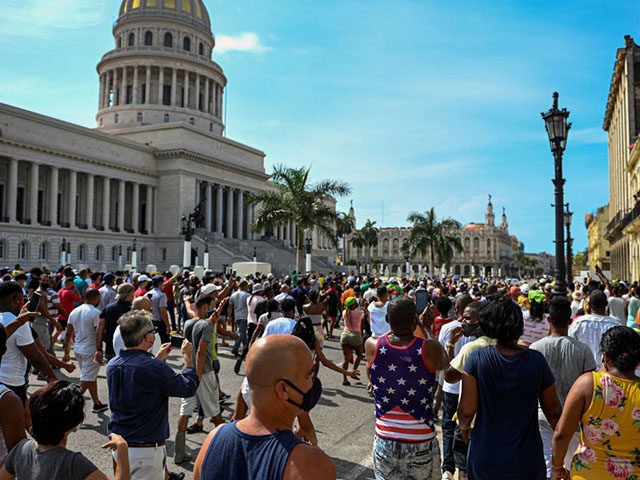The New York Times described chants of “freedom!” at thousands-strong peaceful protests in Cuba on Sunday as one of several “anti-government slogans” popular among the congregated. The Times also erroneously reported the protests were about “food and medicine shortages.”
“Shouting ‘Freedom’ and other anti-government slogans, hundreds of Cubans took to the streets in cities around the country on Sunday to protest food and medicine shortages, in a remarkable eruption of discontent not seen in nearly 30 years,” the Times wrote.
In reality, the thousands of protesters used slogans against socialism and communism to made clear the political nature of their demand: the end of communism on the island.
The Times coverage also included weaponizing Cuban disinformation by suggesting communist Cuba’s “longstanding economic problems” stem from “the American trade embargo, which cuts off its access to financing and imports.”
“In televised remark,” the Times persisted, “Díaz-Canel said … the protests were a form of ‘systemic provocation’ by dissidents doing the bidding of the United States.”
“Within hours of the extraordinary events, the president broke into national television programming to urge government supporters to hit the streets and confront the protesters,” the Times reported, tempering in its translation that Díaz-Canel issued an “order of combat” encouraging civilians to violently assault protesters on the streets.
The Times’ narrow coverage contradicts videos from throughout the island that show both plain-clothed and uniformed state security officers attacking peaceful protesters. Breitbart News reported bystanders in Havana heard sounds of heavy gunfire and beatings of dissidents, while Díaz-Canel called for street “combat” against anyone demanding an end to the regime.
The Times has been historically sympathetic to the Castro regime. In the 1950s, while most Cubans supported efforts against then-President Fulgencio Batista organized by more popular leaders, New York Times reporter Herbert Matthews published flattering, and false, reports praising Fidel Castro and his band of Marxists. Matthews’ reports, beginning in 1957, portrayed Castro as a freedom fighter seeking to restore democracy to the island nation and made him appear far more popular than he was on the island.
Matthews’ articles dignified Castro’s image, giving him credibility both at home and abroad and helping propel his rise to power.
Upon Castro’s success of establishing a revolutionary socialist state in 1959, Castro claimed in New York City his “greatest ploy” was fooling Matthews.
Castro admitted he only had 20 men left at the time of Matthews’ publications but convinced Matthews he had control of a huge army. Matthews’ observations backed this as he wrote, “from the look of things, General Batista cannot possibly hope to suppress the Castro revolt.”
In 2017, the New York Times published a series of articles praising the legacy of communism, which has killed at least 100 million people.

COMMENTS
Please let us know if you're having issues with commenting.